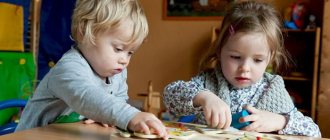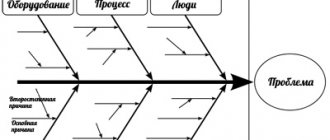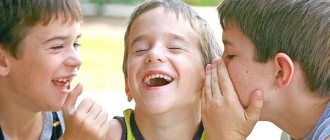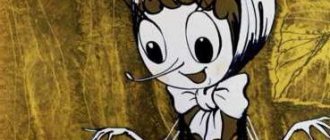Master class “Crossence” as a technique for developing creative thinking
Master Class
“Crossence” as a technique for developing creative thinking
Hello, dear teachers.
Any problem is identified at the diagnostic stage. At the first stage of training, the students in my class underwent a diagnostic “The first step to performance” in the following areas : motivation, adaptation, mental processes, level of development.
Results worth noting.
| № directions | Problem | Result below the average | Mark location |
| 1 | Motivation | 65% | |
| 2 | Adaptation | 33% | |
| 3 | Mental processes (memory) | 50% | |
| 4 | State of the art | 44% |
Mentally put a tick on the line where we have the same problems. Recount the number of marks. Remember their number. Since the overall goal of education is to develop in students the ability to think outside the box, act actively
and creatively,
add one more to your number of tags. Raise your hands if you have at least three of them... So you should be interested in the technology of critical thinking. She is the one who helps solve all these problems. One of the techniques of critical thinking is the “Crossence” technique.
Purpose of the master class:
Demonstrate the use of the “Crossence” method in the classroom as a means of developing motivation, logical and extraordinary creative thinking in students.
Theoretical part
Today we will get acquainted with a creative thinking technique called “Crossence”. Translated from English, the word CROSSENSE means “intersection of meaning.” This technique was developed by our compatriots Sergei Fedin - writer, teacher, mathematician and Vladimir Buslenko - Doctor of Technical Sciences, artist and philosopher. The main point of creating “Crossence” is a puzzle, an intellectual game, a task that is intended to motivate educational, cognitive, creative activities of both children and teachers.
To better understand how this technique works, let’s do a preparatory exercise.
.
Find an associative connection between two concepts: crown - magpie
(the crown shines, and magpies love everything shiny
).
Practical work No. 1
Similar work is carried out on a series of pictures or words. For example, these:
Crown – sun – pine – ax – firewood –?. At the end of the work, you will “close” the chain yourself. Let's look at the first couple of words.
1-2
crown-sun
Teachers' reasoning:
the golden crown glitters, attracts the eye, fascinates with its beauty
and the sun is the same bright yellow color
( 1st answer option
).
This is what lies on the surface, but you need to think bigger, deeper. To make it more convenient to do this, imagine yourself next to this object, remember where you saw it and under what circumstances.
Teachers' thoughts:
seen on a king, royal person, ruler;
the person who controls
state, all
people
;
by order, according to the established laws of which they live;
before whom they bow and have bowed;
without whom many could not imagine life , there were cases when he was idolized
, that is,
they were deified with the heavenly body - the sun
(“Prince Vladimir - Red Sun”);
the one who
If he disobeys his master’s order and
breaks the rules, he will face severe punishment
(2nd answer option )
.
2-3 sun-pine
Teachers' thoughts:
pine is a plant, like any living creature, it reaches out to the sun, to light, to warmth, cannot live without it, and dies.
Let's speed up the reasoning process.
3-4-5-6 pine-axe-firewood-?
Teachers' thoughts:
An ax is a tool that can be used to cut down a tree, prepare firewood and (
finish the chain yourself
) light...(
fire ).
Let's go back to all your statements. As we worked, we broke the material into parts. In each of them the most important, “supporting” words were clearly presented.
Here are your wise thoughts.
It attracts the eye, fascinates with its beauty, controls
people
,
they bow before it, they are drawn to it as a source of light and warmth, they cannot imagine life without it, they die. He is idolized, deified with the sun.
But anyone who breaks the rules for handling him will face severe punishment. Look, all these words were spoken in the process of reasoning in relation to completely different concepts, and were not said about fire, but as a result we got a complete picture about it.
Try to formulate the main idea of this text in one sentence, perhaps emotionally charged.
How great is the importance of fire for a person?!
On what objects can this associative chain be used? ( The world around us, history, life safety)
And if the chain is extended further, for example with the following words: “combustion”, “substance”, “flame”, “color”?
What items will be added to our list? ( Physics, chemistry and even fine arts
). That is, it depends on you and the children’s answers what kind of result we get.
Graphically, the variability of our answers can be shown as follows.
What does this remind you of? ( Possibility Tree)
That’s right, which means that when working with this technique we
also touch upon the process of combinatorics
.
It is also important to note that the associative direction
is one of
the main theories in the problem of studying memory
. Without these connections, normal human mental activity is impossible.
Example from work experience
In addition to the chain of words, a tabular method of depicting associative connections, closed in a standard field of six or nine squares, as for the game “Tic Tac Toe,” has recently become very popular. This is what our chain about “fire” would look like in the table.
It is necessary to create an associative chain based on a number of illustrations, sometimes, at first glance, unrelated to each other. Each picture has a connection with the previous and subsequent ones, and the central one unites several in meaning at once. During lessons with the children, it is more convenient for us to consider the connection between pictures in a spiral, like a snail. The numbering of the squares is given as a hint. The central square is the goal of the chain of reasoning.
| 1 | 2 | 3 |
| 8 | 9 | 4 |
| 7 | 6 | 5 |
Practical work No. 2
.
Try making “Crossences” in groups using prepared pictures. (Tasks in three groups for 2-3 minutes) Name the topic of “Crossence”. Please get started...
While the creative teams are working, let’s look at a few more unusual ways of reading information, looking for original, at first glance, strange, but acceptable explanations. I will ask a riddle for all listeners. “The girl is sitting in prison, and her scythe is on the street.” What is this? (Carrot)
Now try to give as many of your non-standard answers as possible, but so that they do not contradict the conditions of the riddle.
( Beets, turnips, Rapunzel
, Comet,...)
I think that my colleagues are ready to present the results of their work. (Participants voice possible solutions: the one that the “Crossence” solver managed to find, and the one that was intended by its creator).
| 49 |
| ! . ?; «» | |
| @ # & * ~ | 0,1,2,3,4, 5,6,7,8,9 |
Thanks a lot! It was difficult? Yes, you have to work hard, but it’s justified by the children’s interest, their desire to answer and perform “Crossences” on their own.
At what stages of the lesson can the “Crosses” technique be used? ( Create a problem situation or summarize the knowledge acquired by students, sum up in an original way. “Crossence” can also become a creative homework).
The enormous educational potential of “Crossences” should not be overlooked. They can be compiled on the topic of a class hour, a festive event, or an anniversary. They can become a way to organize a collective creative activity.
Conclusion
The Crossence technique meets the following principles:
· Science:
has a scientific basis;
· Efficiency:
gives guaranteed results from the first days of their use;
· Humanity:
improves the quality of education and facilitates the learning process;
· Versatility:
applicable for teaching various academic subjects, suitable for different levels of education, as well as for teaching children with different levels of development;
· Creativity:
aimed at developing extraordinary creative thinking.
This means that the “Crossence” technique helps to form all types of universal educational actions.
Reflection
For those who liked the “Crossence” technique and who will use it in their practice, pick up a green card
.
For those who doubt that they will use this method, take a yellow card
.
Those who believe that this technique is ineffective and has no effect, take a red card.
Place them on your paths. (At the end of the track, remove the hidden word “Goal”) Thank you for your attention!
Memo
Algori:
1) determine the topic, the general idea;
2) search and selection of images illustrating elements;
3) select 9 elements - images related to the idea, topic;
4) find the connection between elements, determine the sequence;
5) concentrate the meaning in one element (9th square);
6) highlight the distinctive features and features of each element.
Prepared by a primary school teacher:
Crossence - a technology for developing critical thinking in preschoolers
Irina Batashan
Crossence - a technology for developing critical thinking in preschoolers
I would like to present to your attention the innovative developing technology “crossence”, which contributes to the formation of creativity, the development of a sense of teamwork, responsibility for the completed task, communication and critical thinking of preschoolers. I bring to your attention a report with a presentation on the use of this technology, which I prepared for the unified regional methodological day. In addition, participants were presented with booklets on the topic. At the beginning I offer you one parable. slide 1
“Once Logic and Intuition argued about the benefits of each of them.
Logic said: - No one can do without me! Without me, a person would not be able to count, compare, analyze, draw conclusions and conclusions.
- Just think, great things! It's not that important! - Intuition objected. “If it weren’t for me, then a catastrophe would happen to a person.” A person would not be able to truly rejoice and perceive the world creatively, in all its colors.
“Everyone can easily do without you.” Creativity is not a necessity. Nobody needs it. And everyone has their own joys. I can live without your joys.
— We can do without your numbers, analytics and comparisons, for sure!
Their argument was heard by Reason.
- Why are you all arguing?
- And who are you?
- I am Reason.
- What do you say about this? You heard our argument. Who is more useful for a person?
“You both have some use,” Reason answered confidently.
- Which of us cannot a person do without?
- Let's think about it. Can an artist do without intuition?
-No.
—Can a merchant do without logic?
- Uh. No. – Logic and Intuition answered in one voice. - But how to live? Based on LOGIC or INTUITION?
- Based on the REASON. "
What is most important in your work, colleagues? Is LOGIC as important as INTUITION and REASON? After all, the new federal standards require the inclusion of logic, reason and intuition
Slide 2 What is crossens ? CROSSENSE means “crossing of meanings.” Nine images are arranged so that each picture has a connection with the previous and subsequent ones, and the central one unites everything in meaning at once. Crossence is a riddle, a puzzle, a rebus.
This technology can be used when conducting educational activities, experimental, educational, independent, leisure activities with children and parents. With the help of cross-sense, you can formulate the purpose and theme of the event, study, consolidate and generalize the studied material, and include it as reflection.
Such creative tasks increase initiative, creativity, develop imagination, fantasy, logical and creative thinking. Preschoolers develop cognitive, informational and communicative activities.
Slide 3 A table of 9 cells is compiled
Sly 4 CROSSENCE COMPILATION ALGORITHM:
1. Determine the topic
2. Select 9 elements (pictures)
3. We find an associative connection between these elements, determine their sequence
4. Concentrate the main meaning in the central fifth square
5. Select images
You can read crossens in one of the following ways: slide 5.6 (Topic PUSHKIN A.S.)
from top to bottom and from left to right (as a rule, reading in Russian, then move only forward and end on the central 5th square, this way you get a chain wrapped in a “snail”;
Slide 7.8 can be started either with the first one or with any recognizable picture. The central square is the square with number 5. At the request of the compiler, it can be connected in meaning with all the images in the crossense; (topic number 7)
slide 9.10, usually you need to establish connections along the perimeter between squares 1–2, 2–3, 3–6, 6–9, 9–8, 8–7, 7–4, 4–1, as well as along the central cross between squares 2–5, 6–5, 8–5 and 4–5. (Theme letter “O”)
Slide 11 was presented to teachers on the topic of Federal State Educational Standards.
Each group of participants was presented with pictures and a diagram of crossence assembly and a compilation algorithm.
Crossence technologies in elementary school lessons (master class)
Master Class
«
“Crossence technologies in a modern lesson”
Target:
Demonstrate the use of the crossence method in the classroom as a means of developing students’ logical and creative thinking.
“Logic is an attempt to understand the real world according to the known scheme of existence created by us.”
Friedrich Nietzsche
“The worse your logic, the more interesting the consequences it can lead to”
Bertrand Russell
- Dear colleagues! I am glad to welcome you to this hall. I would like to start my master class by telling one parable.
«Logic and Intuition once argued about the benefits of each of them.
Logic said:
- No one can do without me! Without me, a person would not be able to count, compare, analyze, draw conclusions and conclusions.
- Just think, great things! It's not that important! - Intuition objected. “If it weren’t for me, then a catastrophe would happen to a person.” A person would not be able to truly rejoice and perceive the world creatively, in all its colors.
“Everyone can easily do without you.” Creativity is not a necessity. Nobody needs it. And everyone has their own joys. I can live without your joys.
— We can do without your numbers, analytics and comparisons, for sure!
Their argument was heard by Reason.
- Why are you all arguing?
- And who are you?
- I am Reason.
- What do you say about this? You heard our argument. Who is more useful for a person?
“You both have some use,” Reason answered confidently.
- Which of us cannot a person do without?
- Let's think about it. Can an artist do without intuition?
-No.
—Can a merchant do without logic?
- Uh... no. – Logic and Intuition answered in one voice. - But how to live? Based on logic or intuition?
“Based on reason.”
— Do you think logic is needed in everyday life?
- No one will argue that every teacher should develop the logical thinking of students. This is a requirement of the Federal State Educational Standard, it is stated in the methodological literature. However, the teacher does not always know how to do this. Mathematics plays a huge role in the development of logical thinking, but I have a question for subject teachers. (Any contestant)
— Doesn’t your subject develop logical thinking?
— I ask my colleagues in the competition to help me and invite them to act as my students.
Today I would like to tell and show my experience in developing logical thinking in the classroom using the “Crossence” technique
- Tell me, is anyone familiar with this technique? Maybe someone uses it in their practice? (Answers).
— What is “Crossens”? The word “crossness” was coined by the authors by analogy with the word “crossword”, which in English means “intersection of meanings.” This technique was developed by our compatriots Sergei Fedin - writer, teacher, mathematician and Vladimir Buslenko - Doctor of Technical Sciences, artist and philosopher. Crossens, first published in 2002 in the journal Science and Life. Crossence is an associative chain closed in a standard field of nine squares for “Tic Tac Toe”. Nine images are arranged in such a way that each picture has a connection with the previous and subsequent ones, and the central one unites several in meaning at once. Connections can be both superficial and deep, but in any case, this is an excellent exercise for developing logical and creative thinking.
You need to read crossens from top to bottom and from left to right (as a rule of reading in Russian), then move only forward and end on the central 5th square, this way you get a chain wrapped in a “snail”. You can start with the first one or with any recognizable picture. The central square is the number 5; it can be connected in meaning with all the images in the crossense. Usually you need to establish connections along the perimeter between squares 1-2, 2-3, 3-6, 6-9, 9-8, 8-7, 7-4, 4-1, as well as along the central cross between squares 2- 5, 6-5, 8-5 and 4-5.
| 1 | 2 | 3 |
| 4 | 5 | 6 |
| 7 | 8 | 9 |
I propose to solve the first crossence. Your task is to explain crossession: to determine what is being said, to leave a story - an associative chain, through the interconnection of images. I give it 2-3 minutes to complete.
1–2 – the crown is made of gold;
2–3 – crows love to carry away everything that glitters, gold also glitters;
1–4 – many kings were compared to the Sun;
3–6 – crow and nightingale – birds;
4–7 – pine reaches towards the Sun;
6–9 – Andersen has fairy tales “The Nightingale” and “The Flint”; fire can be lit from the flint;
7–8 – pine trees are cut with an ax;
8–9 – firewood is needed to light a fire.
2–5, 4–5, 5–6, 5–8 – all words contain the letter “O”.
There is a fairly simple and understandable algorithm for composing crossence.
Crossence compilation algorithm:
1) determine the topic, the general idea;
2) search and selection of images illustrating elements;
3) select 9 elements - images related to the idea, topic;
4) find the connection between elements, determine the sequence;
5) concentrate the meaning in one element (5th square);
6) highlight the distinctive features and features of each element.
I suggest you now try to make a cross-sense on the proposed topic. Here is the text and the necessary images that you can use to create a cross-sense. Time is limited. Please get started.
So I think that my colleagues are ready to present the result of their work. (Submission of work) Thank you very much! It was difficult? Yes, you have to work hard, but it’s justified by the children’s interest, their desire to answer and perform crosses independently.
At what point in the lesson do I use crosses? I will answer
I use crossens:
- when studying new material: deducing the topic of the lesson; establishing a problem situation;
- when consolidating and generalizing the studied material;
- creative homework.
Crossense is a good way not only to find connections and meanings, but also to deepen the understanding of already known concepts and phenomena.
The main point of creating a crossence is a riddle, a conundrum, a rebus, a task that is intended for a specific audience. It is in this capacity that it is interesting to us, teachers. It cannot be denied that, along with logical thinking, visual memory and coherent speech develop.
Reflection.
In Ancient Japan there was such a ritual: when the ship set sail, all relatives saw off the travelers and crew. Ribbons stretched from the mourners all the way to the ship. The ship set sail from the shore, the ribbons were torn. One part of the ribbon remained on the ship, the other in the hands of the mourners. Pieces of tape were stored until the ship returned home. I would like to know your opinion on the use of the Crossence technique
For those who liked this technique and who will use it in their practice, take a red card
.
Those who will use this method, take a yellow card
.
- Those who believe that this technique is ineffective and has no effectiveness, take a green card.
Thank you for your attention!





